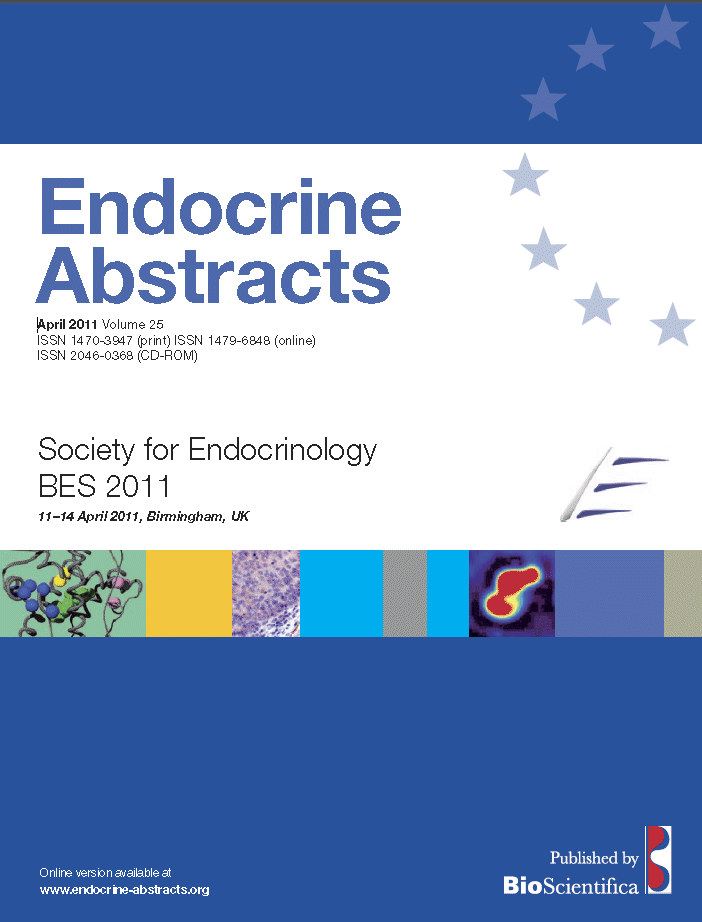Poster Presentations
Steroids
ea0025p283 | Steroids | SFEBES2011
GPs say they rely on endocrinologists to manage adrenal crisis and patient education for Addison’s disease
White Katherine , Mackay Alick
ea0025p284 | Steroids | SFEBES2011
Dehydroepiandrosterone (DHEA) supplementation improves cognitive function in perimenopausal rhesus monkeys
Urbanski Henryk , Renner Laurie , Weiss Alison , Garten Jamie , Sorwell Krystina , Kohama Steven , Neuringer Martha
ea0025p285 | Steroids | SFEBES2011
Measurement of salivary testosterone in female samples using a highly sensitive LC–MS/MS assay
Keevil Brian , McDonald Philip , McDowell Wendy , Wallace Alan , Wu Fred
ea0025p286 | Steroids | SFEBES2011
Steroid Replacement Education: Impact on Patients and their Carers
Saeed Mujahid , Aung Theingi , MacDonald Judy , Wass John , Karavitaki Niki
ea0025p287 | Steroids | SFEBES2011
How reproducible are LC–MS testosterone results? A calibration exercise
Keevil Brian , McDonald Philip , Owen Laura
ea0025p288 | Steroids | SFEBES2011
The effect of prednisolone on different cortisol methods
ea0025p289 | Steroids | SFEBES2011
Glucocorticoid receptor antagonism as a decision making tool in patients with adrenal incidentaloma and low-grade excess cortisol secretion: a pilot study
Debono Miguel , Houghton Sam , Eastell Richard , Ross Richard , Newell-Price John
ea0025p290 | Steroids | SFEBES2011
Urinary tetrahydroaldosterone excretion is determined by rising urinary sodium excretion in patients with chronic kidney disease
McQuarrie Emily , Mark Patrick , Fraser Robert , Davies Eleanor , Connell John , Freel E Marie
ea0025p291 | Steroids | SFEBES2011
Urinary tetrahydrodeoxycorticosterone excretion is a significant independent predictor of LV mass in patients with chronic kidney disease
McQuarrie Emily , Mark Patrick , Patel Rajan , Fraser Robert , Davies Eleanor , Steedman Tracey , Connell John , Freel E Marie
ea0025p292 | Steroids | SFEBES2011
Glycyrrhetinic acid disrupts the synthesis of adrenocorticosteroid hormones at multiple sites
Al-Dujaili Emad , Kenyon Christopher , Nicol Moira , Mason Ian
ea0025p293 | Steroids | SFEBES2011
Clinical outcomes of 250 μg short synacthen tests in a tertiary referral centre
Tan Hiang Leng , Dampetla Srilatha , Ng Jen M , Wakil Ammar
ea0025p294 | Steroids | SFEBES2011
Cortisol decreases lipogenesis in human hepatocytes
Nasiri Maryam , Gathercole Laura , Hauton David , Morgan Stuart , Bujalska Iwona , Stewart Paul , Tomlinson Jeremy
ea0025p295 | Steroids | SFEBES2011
Systems biology reveals a novel mechanism regulating glucocorticoid action
Morgan David , Han Namshik , Matthews Laura , Norman Michael , Brass Andy , Ray David
ea0025p296 | Steroids | SFEBES2011
Spitting out the issues: Identifying optimal procedures for saliva collection and storage
Cooper Gillian , Bentley Gillian
ea0025p297 | Steroids | SFEBES2011
Effects of endocrine disruptors in adult rats: integrative evaluation from gonadal steroidogenic gene expression profiles to hormonal balance
Quignot Nadia , Desmots Sophie , Barouki Robert , Lemazurier Emmanuel
ea0025p298 | Steroids | SFEBES2011
An unusual case of hypoadrenalism presenting with hypercalcaemia following severe Legionella sepsis
Bentley Hayley , Kyaw Ye , Bingham Emma , Tringham Jennifer
ea0025p299 | Steroids | SFEBES2011
A retrospective analysis of Short Synachthen Tests to assess the effect of a change in the normal reference range
Fox Thomas , Clough Vicky , Flanagan Daniel
ea0025p300 | Steroids | SFEBES2011
Concurrent analysis of 10 serum steroids by mass spectrometry: investigation of the viability of the Perkin-Elmer CHS™ MSMS steroids kit on a waters xevo mass spectrometer with acquity UPLC system
Taylor Angela , Shackleton Cedric , Taylor Stuart , Jensen Ulrich Glumer , Ojala Marko , Arlt Wiebke
ea0025p301 | Steroids | SFEBES2011
An atypical case of familial glucocorticoid deficiency without pigmentation caused by coexistent homozygous mutations in MC2R (T152K) and MC1R (R160W)
Hughes Claire , Turan Serap , Atay Zeynep , Guran Tulay , Bereket Abdullah , Clark Adrian , Metherell Louise
ea0025p302 | Steroids | SFEBES2011
Cushing's syndrome in a patient with two lung tumours
Haniff Haliza , Scarsbrook Andrew F , Orme Stephen M
ea0025p303 | Steroids | SFEBES2011
Accidental long-term ingestion of androgenic steroid in a young female: a case report
Katreddy Venkata , Dale Jane , Siddique Haroon
ea0025p304 | Steroids | SFEBES2011
Exogenous Cushing's syndrome due to topical corticosteroid application
Elsadig Ahmed , Kaimal Nisha , Kearney Tara
ea0025p305 | Steroids | SFEBES2011
Is there a threshold morning cortisol level at which to perform the short synacthen test?
Bujawansa Sumudu , Kunasegaran Shalini , McNulty Steve , Hardy Kevin , Al-jabouri Mohammad , Furlong Niall , Srinivas-Shankar Upendram
ea0025p306 | Steroids | SFEBES2011
Why does MRAP2 fail to save familial glucocorticoid deficiency type 2 patients?
Gorrigan Rebecca , Guasti Leonardo , Clark Adrian , Chan Li
ea0025p307 | Steroids | SFEBES2011
Epidemiology of Addison's disease in the area of banbury, oxfordshire
Komninos John , Kohler Sybil , Karavitaki Niki , Wass John
ea0025p308 | Steroids | SFEBES2011
Derivatisation of estrogens enhances sensitivity of analysis by liquid chromatography tandem mass spectrometry
Homer Natalie , Cobice Diego , Gibb Fraser , Naredo Gregorio , Denham Scott , Walker Brian , Andrew Ruth
ea0025p309 | Steroids | SFEBES2011
Utility of basal DHEAS measurement in the detection of subclinical autonomous glucocorticoid hypersecretion in adrenal incidentaloma
Annamalai Anand K , Kandasamy Narayanan , Freeman Natalie , Venugopal Kuhan , Chia Jonathan , Shaw Ashley , Simpson Helen L , Halsall David , Gurnell Mark
ea0025p310 | Steroids | SFEBES2011
Effects of topical betamethasone and calcipotriol therapy in improving the tolerogenic potential of a ‘vaccine’ for type 1 diabetes
Ali Mohammad Alhadj , Thrower Sally , Harris Stephanie , Wong Susan , Dayan Colin
ea0025p311 | Steroids | SFEBES2011
Hepatic 11β-hydroxysteroid dehydrogenase type 1 expression is dynamically related across the liver lobule and is linked to metabolic status
Ahmed Adeeba , Semjonous Nina , Rabbitt Elizabeth , Stewart Paul




